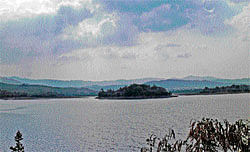
The district of Chikmagalur nestling in the pristine Malnad area of the Western Ghats is studded with many tourist attractions.
Be it the tall peaks of Mullainagiri and Baba Budangiri, hill stations like Kudremukh and Kemmanagundi, the charming waterfalls of Hebbe and Kalhatti or the densely wooded sanctuaries of wildlife such as the Muthodi and Bhadra; the coffee town of Chikmagalur serves as a convenient base from where you can venture out to these exciting destinations. Also, as the town borders with the plains to the east, there are a few little known places with lakes and rivers that are equally charming.
The huge lake of Ayyanakere is one such spot that deserves to be on a tourist’s itinerary but can hardly make it due to the lack of publicity and a dearth of tourist facilities. But the beauty and peaceful ambience of the place make it a worthy destination.
About 20 km north of Chikmagalur on the way to Kadur, Ayyanakere lake can be reached from the nearest town of Sakrepatna, which is also significant for some history and a few temples.
Though the area was under the rule of different dynasties such as the Hoysalas, Keladi rulers and Mysore kings, it was during the reign of Rukmangada Raya (12th century) that Ayyanakere lake was built. He was ably supported in the venture not only by the local chiefs but also by the Hoysala ruler, Narasimha I.
The sprawling lake was built to meet the needs of the people whose livelihood was agriculture. Ever since, this large perennial water body has supported cultivation for as many as 1500 ha extending over 20 villages at the least. With an abundant water supply, the main produce here is coconut, arecanut and sugarcane. Some believe nearby town of Sakrepatna gets its name from the large amounts of sugarcane grown there (sakre in kannada means sugar), but it is actually a corrupted version of Sakharaya Patna, named after a palegar (chieftain) of the same name.
Ayyanakere, also called Dodda Madagadakere was formed at the eastern base of the Baba Budangiri hill range when an embankment was constructed across the river Gauri Halla which originates in the area. As it flows over the eastern plains, it acquires the name of Veda and after joining Avati stream it flows as Vedavati .
Legends
It is said that the lake used to breach repeatedly but after following the rituals suggested by a contemporary saint, Nirvanaswamy, the problem was overcome. Another legend associated with the lake is more intriguing. During the days of Rukmangada Raya, the lake was looked after by a nirganti (waterman) named Honna Billa.
One new moon day when a cowherd, Channa Billa, was with him the goddess guarding the lake announced that the lake would breach inundating the nearby town. Fearing disaster, the duo requested the goddess to delay the calamity until they went to town and came back with instructions from their master.
They wondered how to save the village and their people. Upon remembering that the goddess would delay the flood until they returned, they turned into martyrs by beheading themselves at the town gate. Now a mantapa stands there in their honour. The inundation never occurred.
The conical hill Shakunagiri rising to about 4,600 ft forms a picturesque backdrop for the lake. Several Hoysala styled sculptures can be found in the temple on the banks of the lake dedicated to Shiva. The intricately carved standing image of Vishnu is a masterpiece. The hill offers a great opportunity for trekking enthusiasts.
Ayyanakere is six km northwest of Sakrepatna which is about 20 km from Chikmagalur on the road to Kadur. The nearest railway station is Kadur, also at a distance of 20 km.